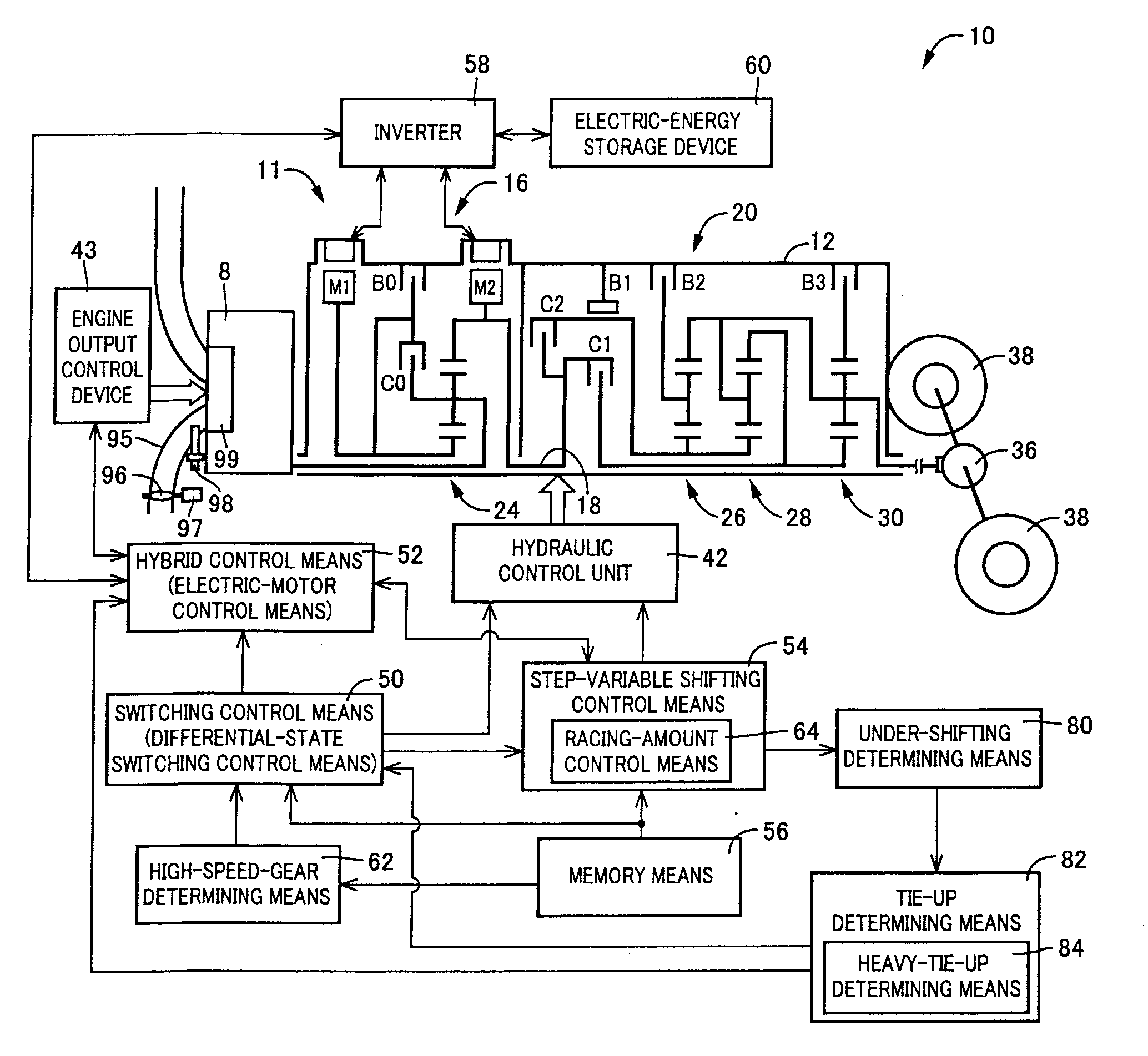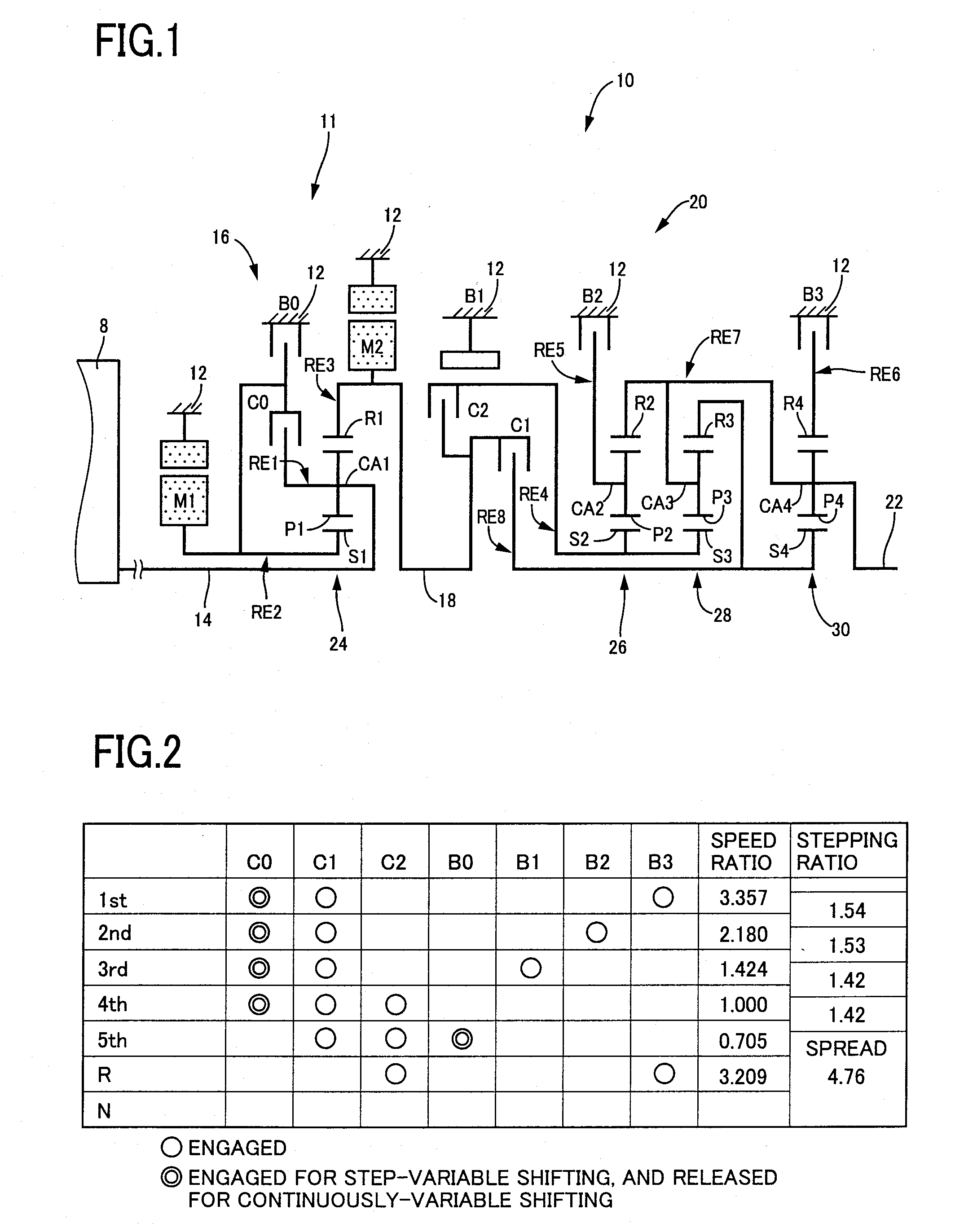Controller of driving device for vehicle
a control device and vehicle technology, applied in the direction of dynamo-electric gear control, gear control, instruments, etc., can solve the problems of deteriorating fuel economy of the vehicle, inability to provide any power transmission mechanism having the advantages, and the vehicular drive system suffering from a similar problem, so as to improve the efficiency of the continuously variable shifting control of the continuously variable transmission portion, the effect of reducing the required size of the second electric motor
- Summary
- Abstract
- Description
- Claims
- Application Information
AI Technical Summary
Benefits of technology
Problems solved by technology
Method used
Image
Examples
embodiment 1
[0095]FIG. 1 is s schematic view for explaining an a transmission mechanism 10 constituting a part of a drive system for a hybrid vehicle, which drive system is controlled by a control apparatus according to one embodiment of this invention. As shown in FIG. 1, the transmission mechanism 10 includes: an input rotary member in the form of an input shaft 14; a continuously-variable transmission portion in the form of a differential portion 11 connected to the input shaft 14 either directly, or indirectly via a pulsation absorbing damper (vibration damping device) not shown; a step-variable transmission portion in the form of an automatic transmission portion 20, which functions as a multiple-step transmission disposed between the differential portion 11 and drive wheels 38 of the vehicle, and which is connected in series via a power transmitting member 18 (power transmitting shaft) to the transmission portion 11 and the drive wheels 38; and an output rotary member in the form of an ou...
embodiment 2
[0211]In the first embodiment described above, the differential portion 11 is switched to the continuously-variable shifting state to reduce the influence of the tie-up phenomenon of the automatic transmission portion 20 on the engine 8, for reducing the shock of the clutch-to-clutch shifting action, when the clutch-to-clutch shifting action of the automatic transmission portion 20 is brought into the tie-up state in the non-continuously-variable shifting state of the differential portion 11. To reduce the influence of the tie-up phenomenon of the automatic transmission portion 20, however, the differential portion 11 need not be switched to the non-continuously variable shifting state, provided the engine speed NE can be controlled as needed, irrespective of a change of the rotating speed of the rotary element of the automatic transmission portion 20, by cutting off the power transmitting path between the automatic transmission portion 20 and the engine 8, for example.
[0212]When th...
embodiment 3
[0242]In the preceding embodiments, the differential portion 11 is switched to the continuously-variable shifting state, or the input clutch which permits or inhibits the power input from the differential portion 11 to the automatic transmission portion 20 is released or partially engaged, when the clutch-to-clutch shifting action of the automatic transmission portion 20 is in the tie-up state while the differential portion 11 is placed in the non-continuously-variable shifting state. Thus, the influence of the tie-up phenomenon of the automatic transmission portion 20 on the engine 8 is reduced to reduce the shifting shock.
[0243]However, the engine speed NE may be influenced by a shifting action of the automatic transmission portion, leading to generation of the shifting shock, even when the shifting action of the automatic transmission portion 20 is not in the tie-up state.
[0244]In a well known power transmitting system provided with a torque converter, a fluid coupling or any oth...
PUM
 Login to View More
Login to View More Abstract
Description
Claims
Application Information
 Login to View More
Login to View More - R&D
- Intellectual Property
- Life Sciences
- Materials
- Tech Scout
- Unparalleled Data Quality
- Higher Quality Content
- 60% Fewer Hallucinations
Browse by: Latest US Patents, China's latest patents, Technical Efficacy Thesaurus, Application Domain, Technology Topic, Popular Technical Reports.
© 2025 PatSnap. All rights reserved.Legal|Privacy policy|Modern Slavery Act Transparency Statement|Sitemap|About US| Contact US: help@patsnap.com



